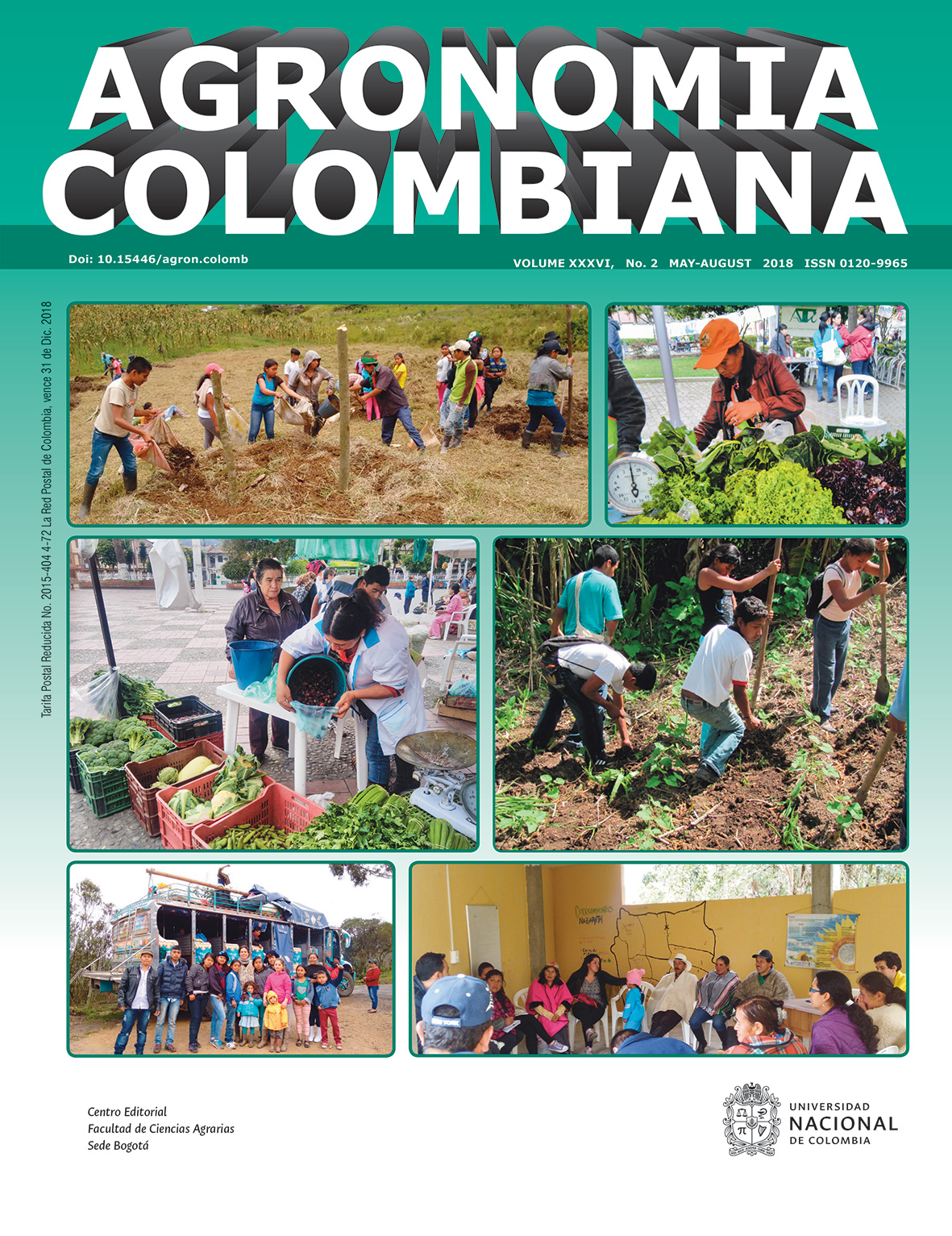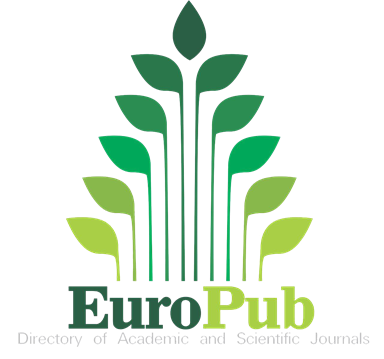Organic substrate and organic foliar fertilizer effect on chlorophyll index and growth in Umbuzeiro seedlings
Efectos de substratos orgánicos y fertilizantes orgánicos foliares en el crecimiento e índices de clorofila en plántulas de Umbuzeiro
DOI:
https://doi.org/10.15446/agron.colomb.v36n2.69866Keywords:
Spondias tuberosa, organic inputs, native fruit. (en)Spondias tuberosa, insumos organicos, frutal nativo. (es)
Downloads
The umbuzeiro (Spondias tuberosa Arr. Cam.) is a fruit tree originating from the Caatinga biome that enjoys high acceptance in the market for in natura consumption or industrialized products; as a result, its cultivation has become of great importance for the region of Northeast Brazil. The objective was to evaluate growth, substrate temperature and chlorophyll indices in umbuzeiro seedlings at organic substrate levels and with organic foliar fertilizer (EcoLife®) applications. The experimental design was a randomized block with a factorial arrangement of 5×2, with four replicates and three plants per experiment unit. The factors corresponded to the proportions of the organic compost to the substrates (0, 25, 50, 75 and 100%), with and without foliar applications of 1% organic foliar fertilizer. The growth, leaf area and chlorophyll indices of the umbuzeiro seedlings were higher in the treatments with organic compost and foliar applications of organic foliar fertilizer.
El umbuzeiro (Spondias tuberosa Arr. Cam.) es un arbol frutal originario del bioma Caatinga con gran aceptacion en el mercado para consumo in natura o productos industrializados. Debido a esto, su cultivo ha adquirido gran importancia para la region del Nordeste brasileno. El objetivo fue evaluar el crecimiento, temperatura del sustrato e indices de clorofila en plantulas de umbuzeiro en niveles de compuestos organicos en el sustrato y aplicacion foliar de fertilizante foliar organico (EcoLife®). El delineamiento experimental utilizado fue en bloques al azar, con arreglo factorial de 5×2, con cuatro repeticiones y tres plantas por unidad experimental. Los factores corresponden a las proporciones de compuesto organico a los sustratos (0, 25, 50, 75 y 100%) en el sustrato con y sin aplicación foliar de fertilizante foliar organico a 1%. El crecimiento, área foliar e indices de clorofila de plantulas de umbuzeiro fue mayor en los tratamientos con compuesto organico y aplicacion foliar de fertilizante organico.
References
Ansari, R.A. and I. Mahmood. 2017. Optimization of organic and bio-organic fertilizers on soil properties and growth of pigeon pea. Sci. Hortic. 226, 1-9. Doi: 10.1016/j.scienta.2017.07.033.
Bacilio, M., M. Moreno, and Y. Bashan. 2016. Mitigation of negative effects of progressive soil salinity gradients by application of humic acids and inoculation with Pseudomonas stutzeri in a salt-tolerant and a salt-susceptible pepper. Appl. Soil Ecol. 107, 394-404. Doi: 10.1016/j.apsoil.2016.04.012.
Braga, B.B., F.H. Nunes Junior, R.M. Barbosa, P.O.B. Brito, K. Martins, P.H.A. Medeiros, and F.A. Gondim. 2017. Biomass production and antioxidative enzyme activities of sunflower plants growing in substrates containing sediment from a tropical reservoir. J. Agric. Sci. 9(5), 95-106. Doi: 10.5539/jas.v9n5p95.
Cavalcante, A.G., R.C. Araújo, A.C.P. Cavalcante, A.S. Barbosa, M.A. Diniz Neto, B.F. Matos, D.S. Oliveira, and J.F.C. Zuza. 2016. Production ofyellow passion fruit seedlings on substrates with different organic compounds. Afr. J. Agric. Res. 11(12), 1086-1091. Doi: 10.5897/AJAR2015.10777.
Cavalcanti, F.R., M.L.V. Resende, A.B. Zacaroni, P.M. Ribeiro Junior, J.C.B. Costa, and R.M. Souza. 2006. Acibenzolar-S-Metil e Ecolife na indução de respostas de defesa do tomateiro contra a mancha bacteriana (Xanthomonas vesicatoria). Fitopatol. Bras. 31(4), 372-380. Doi: 10.1590/S0100-41582006000400007.
Chiti, T., L. Gardin, L. Perugini, R. Quarantino, F.P. Vaccari, F. Miglietta, and R. Valentini. 2012. Soil organic carbon stock assessment for the different cropland land uses in Italy. Biol. Fert. Soils. 48, 9-17. Doi: 10.1007/s00374-011-0599-4.
Conant, R.T., M.G. Ryan, G.A. Agren, H. Birge, E.A. Davidson, P.E. Eliasson, S.E. Evans, S.D. Frey, C.P. Giardina, F.M. Hopkins, R.H. Nen, M.U.F. Kirschbaum, J.M. Lavallee, J.L. Feld, W.J. Parton, J.M. Steinweg, M.D. Wallenstein, J.A.M. Wetterstedt, and M.A. Bradford. 2011. Temperature and soil organic matter decomposition rates-synthesis of current knowledge and a way forward. Global Change Biol. 17, 3392-3404. Doi: 10.1111/j.1365-2486.2011.02496.x.
Costa, F.R., E.R. Rêgo, M.M. Rêgo, D.G. Neder, S.M. Silva, and A.P.P. Schunemann. 2015. Análise biométrica de frutos de umbuzeiro do semiárido brasileiro. Biosci. J. 31(3), 682-690. Doi: 10.14393/BJ-v31n3a2015-22844.
Cruz, F.R.S., L.A. Andrade, and R.C. Feitosa. 2016. Produção de mudas de umbuzeiro (Spondias tuberosa Arruda Câmara) em diferentes substratos e tamanho de recipientes. Ci. Fl. 26(1), 69-80. Doi: 10.5902/1980509821092.
Empresa Brasileira de Pesquisa Agropecuária - EMBRAPA. 2013. Sistema brasileiro de classificação de solos. (3rd ed.). Embrapa, Brasilia, Brasil.
Ferreira, D.F. 2011. Sisvar: a computer statistical analysis system. Ciência e Agrotecnologia 35(6), 1039-1042. Doi: 10.1590/S1413-70542011000600001.
Furtado, L.M., A.C.C. Rodriguez, V.S. Araújo, L.L.S. Silva, and A.M. Catarino. 2010. Utilização de Ecolife® e Acibenzolar-s-metil (ASM) no controle da antracnose da banana em pós-colheita. Summa Phytopathol. 36(3), 237-239. Doi: 10.1590/S0100-54052010000300009.
Galvão, M.S., N. Narain, M.S.P. Santos, and M.L. Nunes. 2011. Volatile compounds and descriptive odor attributes in umbu (Spondias tuberosa) fruits during maturation. Food Res. Int. 44, 1919-1926. Doi: 10.1016/j.foodres.2011.01.020.
Hartley, I.P. and P. Ineson 2008. Substrate quality and the temperature sensitivity of soil organic matter decomposition. Soil Biol. Biochem. 40, 1567-1574. Doi: 10.1016/j.soilbio.2008.01.007.
Li, J., X. Tong, M.K. Awasthi, F. Wu, S. Ha, J. Ma, X. Sun, and C. He. 2018a. Dynamics of soil microbial biomass and enzyme activities along a chronosequence of desertified land revegetation. Ecol. Eng. 111, 22-30. Doi: 10.1016/j.ecoleng.2017.11.006.
Li, X., J. Simunek, H. Shi, J. Yan, Z. Peng, and X. Gong. 2017. Spatial distribution of soil water, soil temperature, and plant roots in a drip-irrigated intercropping field with plastic mulch. Eur. J. Agron. 83, 47-56. Doi: 10.1016/j.eja.2016.10.015.
Li, Y., C. Liu, J. Zhang, H. Yang, L. Xu, Q. Wang, L. Sack, X. Wu, J. Hou, and N. He. 2018b. Variation in leaf chlorophyll concentration from tropical to cold-temperate forests: association with gross primary productivity. Ecol. Indic. 85, 383-389. Doi: 10.1016/j.ecolind.2017.10.025.
Lins Neto, E.M.F., N. Peroni, and U.P. Albuquerque. 2010. Traditional knowledge and management of Umbu (Spondias tuberosa, Anacardiaceae): an endemic species from the SemiArid region of northeastern Brazil. Econ. Bot. 64, 11-21. Doi: 10.1007/s12231-009-9106-3.
Melo, A.P.C., A. Seleguini, M.N. Castro, F.A. Meira, J.M.S. Gonzaga, and K.I. Haga. 2012. Superação de dormência de sementes e crescimento inicial de plántulas de umbuzeiro. Semin. Cienc. Agrar. 33(4), 1343-1350. Doi: 10.5433/1679-0359.2012v33n4p1343.
Mertens, J., S. Germer, J. Germer, and J. Sauerborn. 2017. Comparison of soil amendments for reforestation with a native multipurpose tree under semiarid climate: root and root tuber response of Spondias tuberosa. For. Ecol. Manage. 396, 1-10. Doi: 10.1016/j.foreco.2017.04.010.
Medeiros, E.V., K.A. Notaro, J.A. Barros, W.S. Morales, A.O. Silva, and K.A. Moreira. 2014. Absolute and specific enzymatic activities of sandy entisol from tropical dry forest, monoculture and intercropping areas. Soil Tillage Res. 145(1), 208-215. Doi: 10.1016/j.still.2014.09.013.
Medeiros, E.V ., K.A. Notaro , B.M. Souza, A.O. Silva , G.P. Duda, and M.M. Silva. 2015. População microbiana, disponibilidade de nutrientes e crescimento de umbuzeiro em substratos contendo resíduos orgánicos. Revista Caatinga 28(3), 47-53. Doi: 10.1590/1983-21252015v28n305rc.
Moinet, G.Y.K., J.E. Hunt, M.U.F. Kirschbaum , C.P. Morcom, A.J. Midwood, and P. Millard. 2018. The temperature sensitivity of soil organic matter decomposition is constrained by microbial access to substrates. Soil Biol. Biochem . 116, 333-339. Doi: 10.1016/j.soilbio.2017.10.031.
Mota, C.S., F.G. Silva, P.D.M. Freiberger, D.N. Reis, and G.C. Méndez. 2018. Parameters of physiology, nutrition and quality of Eugenia dysenterica DC seedlings grown in organic substrates from the agricultural industry. J. Agric. Sci . 10(1), 73-84. Doi: 10.5539/jas.v10n1p73.
Nascimento, L.C., A.R. Nery, and L.N. Rodríguez. 2008. Controle de Colletotrichum gloeosporioides em mamoeiro, utilizando extratos vegetais, indutores de resistência e fungicida. Acta Sci. Agron. 30(3), 313-319. Doi: 10.4025/actasciagron.v30i3.3500.
Reis, R.V., N. Fonseca, C.A.S. Ledo, L.S.A. Gonçalves, F.L. Partelli, M. G.M. Silva, and E.A. Santos. 2010. Estádios de desenvolvimento de mudas de umbuzeiros propagadas por enxertia. Cienc. Rural 40(4), 787-792. Doi: 10.1590/S0103-84782010005000043.
Silva, C.A.D., E.V. Medeiros, C.B. Bezerra, W.M. Silva, J.A. Barros , and U.J. Santos. 2013. Interferência da incorporação de matéria orgánica no solo no controle da podridão negra da mandioca, causada por Scytalidium lignicola. Biosci. J. 29(6), 1823-1831.
Zeraik, M.L., E.F. Queiroz, L. Marcourt, O. Ciclet, I. Castro-Gamboa, D.H.S. Silva, M. Cuendet, V.S. Bolzani, and J.L. Wolfender. 2016. Antioxidants, quinone reductase inducers and acetylcholinesterase inhibitors from Spondias tuberosa fruits. J. Funct. Foods 21, 396-405. Doi: 10.1016/j.jff.2015.12.009.
How to Cite
APA
ACM
ACS
ABNT
Chicago
Harvard
IEEE
MLA
Turabian
Vancouver
Download Citation
License
Copyright (c) 2019 Agronomía Colombiana

This work is licensed under a Creative Commons Attribution-NonCommercial-ShareAlike 4.0 International License.
© Centro Editorial de la Facultad de Ciencias Agrarias, Universidad Nacional de Colombia
Reproduction and quotation of material appearing in the journal is authorized provided the following are explicitly indicated: journal name, author(s) name, year, volume, issue and pages of the source. The ideas and observations recorded by the authors are their own and do not necessarily represent the views and policies of the Universidad Nacional de Colombia. Mention of products or commercial firms in the journal does not constitute a recommendation or endorsement on the part of the Universidad Nacional de Colombia; furthermore, the use of such products should comply with the product label recommendations.
The Creative Commons license used by Agronomia Colombiana journal is: Attribution - NonCommercial - ShareAlike (by-nc-sa)

Agronomia Colombiana by Centro Editorial of Facultad de Ciencias Agrarias, Universidad Nacional de Colombia is licensed under a Creative Commons Reconocimiento-NoComercial-CompartirIgual 4.0 Internacional License.
Creado a partir de la obra en http://revistas.unal.edu.co/index.php/agrocol/.




















